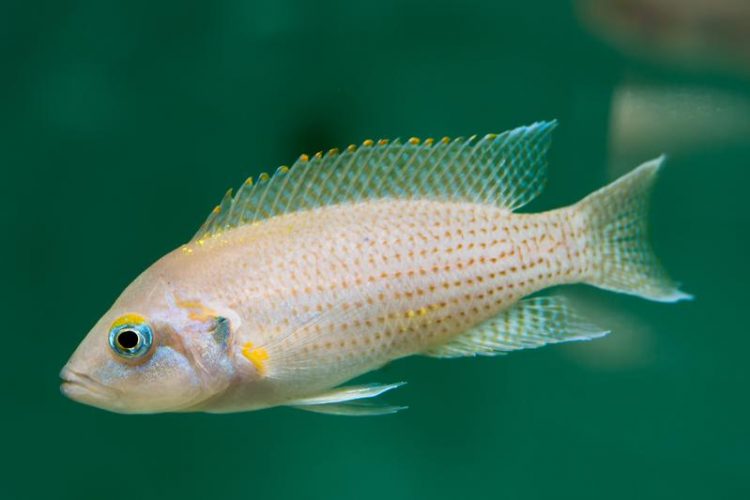The dark side of cichlid fish: from cannibal to caregiver

Female cichlid fish switch to filial cannibalism after longer periods without eggs. Michael Bernkopf/Vetmeduni Vienna
In the eyes of the human beholder, the consumption of one's own offspring is not a particularly nice act, and it is also often viewed as maladaptive, that is, an aberration. However, under some circumstances this behaviour can be a useful way of terminating parental care. When the costs of providing care are extremely high or the benefits of performing care are especially low, parents will sometimes eat their own young. This is called filial cannibalism. This behaviour enables them to cease to care while recouping lost energy.
Most studies examining the link between the cost/benefit ratio of care and filial cannibalism have focused on species with male-only care. In contrast, filial cannibalism in species with biparental caring systems, i.e. where both males and females care for the offspring, has been rarely studied.
Researchers from the Konrad Lorenz Institute of Ethology wanted to examine the transition from cannibal to caring parent in biparental species. They conducted experiments with Neolamprologus caudopunctatus, a biparental species of cichlid fish endemic to Lake Tanganyika, where it occurs along the Zambian shores.
A long time without parental care duties turns cichlids into cannibals
They concluded that it is important for the fish to perceive a continuous presence of eggs in their breeding cavity to keep acting in “parental mode” – it did not matter whether the eggs or hatched young were their own or mixed with foreign brood. Cannibalism occurred when eggs were taken away for extended periods and then returned. The extent of cannibalism was dependent on the size and age of the brood. “Our theory was that longer phases of parental care keep the fish in “parenting mode”.
In this condition it actually did not matter whether they were caring for their own or foreign eggs,” explains behavioural ecologist Filipa Cunha-Saraiva. This likely has to do with hormonal changes happening due to a loss of visual and tactile stimuli. Spawning pairs, on the other hand, never engaged in egg cannibalism, whereas non-spawning pairs immediately devoured foreign broods of eggs.
Female cichlids eat their offspring more often than males
The scientists were also surprised to learn that across all experiments cannibalism was mostly performed by the females. Female filial cannibalism is often associated with increased environmental stress or reduced food provisioning.
“Males were even actively prevented by females attending brood cavities from entering the cavity. This way the females effectively had the power to decide whether to terminate or continue parental care,” Cunha-Saraiva explains This study is among the first to show that both females and males devour their own young. These results expand the scientific understanding of cannibalism in biparental species.
Service:
The article From cannibal to caregiver: tracking the transition in a cichlid fish by Filipa Cunha-Saraiva, Sigal Balshine, Richard H. Wagner, and Franziska C. Schaedelin was recently published online in the journal Animal Behaviour.
https://www.sciencedirect.com/science/article/pii/S0003347218300824?via%3Dihub
This study was financed by the Austrian Science Fund (FWF: standalone project FWF: P 27461). S.B. is supported by an NSERC discovery and accelerator grants (2016-05772).
About the University of Veterinary Medicine, Vienna
The University of Veterinary Medicine, Vienna in Austria is one of the leading academic and research institutions in the field of Veterinary Sciences in Europe. About 1,300 employees and 2,300 students work on the campus in the north of Vienna which also houses five university clinics and various research sites.
Outside of Vienna the university operates Teaching and Research Farms. The Vetmeduni Vienna plays in the global top league: in 2017, it occupies the excellent place 8 in the world-wide Shanghai University veterinary in the subject “Veterinary Science”. http://www.vetmeduni.ac.at
Scientific Contact:
Filipa Cunha-Saraiva
Konrad Lorenz Institute of Ethology
University of Veterinary Medicine Vienna (Vetmeduni Vienna)
T +43 1 25077-7419
filipa.cunha-saraiva@vetmeduni.ac.at
Released by:
Georg Mair
Science Communication / Corporate Communications
University of Veterinary Medicine Vienna (Vetmeduni Vienna)
T +43 1 25077-1165
georg.mair@vetmeduni.ac.at
http://www.vetmeduni.ac.at/en/infoservice/presseinformation/presse-releases-2018…
Media Contact
All latest news from the category: Life Sciences and Chemistry
Articles and reports from the Life Sciences and chemistry area deal with applied and basic research into modern biology, chemistry and human medicine.
Valuable information can be found on a range of life sciences fields including bacteriology, biochemistry, bionics, bioinformatics, biophysics, biotechnology, genetics, geobotany, human biology, marine biology, microbiology, molecular biology, cellular biology, zoology, bioinorganic chemistry, microchemistry and environmental chemistry.
Newest articles

A ‘language’ for ML models to predict nanopore properties
A large number of 2D materials like graphene can have nanopores – small holes formed by missing atoms through which foreign substances can pass. The properties of these nanopores dictate many…

Clinically validated, wearable ultrasound patch
… for continuous blood pressure monitoring. A team of researchers at the University of California San Diego has developed a new and improved wearable ultrasound patch for continuous and noninvasive…

A new puzzle piece for string theory research
Dr. Ksenia Fedosova from the Cluster of Excellence Mathematics Münster, along with an international research team, has proven a conjecture in string theory that physicists had proposed regarding certain equations….



